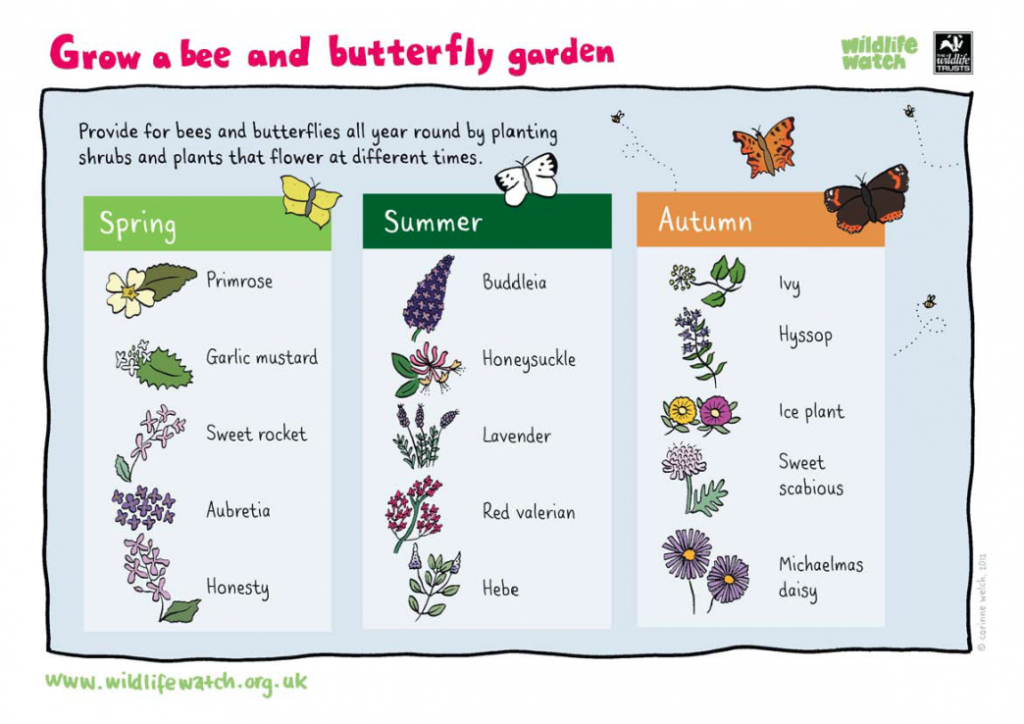Bumble bees are vitally important for pollinating hundreds of plant species, including many crops. But they are under threat from the loss and degradation of our habitats due to pressures such as development, agricultural intensification and climate change. There are 25 species in the UK, but three of these are already extinct.
Bumble bees look for certain types of flowers. Those with shorter tongues need short, open flowers, with nectar within easy reach. This includes flowers from the daisy family and alliums, which have a number of small flowers on one stalk. This type of flower offers a small reward for each probe, but those bumble bees with long tongues can enjoy deeper flowers like honeysuckle, which have significantly more nectar per flower.
Some bee species have even resorted to ‘robbing’ nectar by cutting a hole in the base of the flower and getting to it that way! The flower loses out because this means its pollen is not transported to other flowers nearby.
Having some early and some late flowers in your planting mix will prolong the nectar season for bumble bees
Some bumblebee flower favourites
- The buff-tailed bumblebee (Bombus terrestris) and white-tailed bumblebee (Bombus lucorum) prefer short, open flowers, such as white clover and comfrey. Both are hole-biting, ‘nectar robbers’. The buff-tailed bumblebee rarely visits pendulous flowers as its large size means it is not agile enough to do so.
- The garden bumblebee (Bombus hortorum) has a long tongue, so it can visit flowers with petals that form long tubes, such as honeysuckle, delphiniums and catmint.
- The red-tailed bumblebee (Bombus lapidaries) is a large bee that likes to land on flowers with ‘platforms’, such as daisies and knapweeds.
- The early bumblebee (Bombus pratorum) is a small, agile bee, with a medium-length tongue, which means it can probe a range of flower depths and is able to visit upside-down and drooping flowers, such as comfrey and viper’s-bugloss.
- The common carder bee (Bombus pascuorum) is long-tongued and able to get nectar from long-tubed flowers, such as the late flowers of white dead-nettle. Male bees seem to visit compound daisy-like flowers, such as marsh thistle, more than females.
30 Plants popular with bumblebees
As with any planting for nectar, having some early and late flowers in the mix will prolong the nectar season for bumblebees. Planting them in drifts will help bees recognise them and allows them to visit repeatedly.
- Agastache (agastache sp)
- Betony (stachys officianlis)
- Borage (borago officianalis)
- Broad bean (vicia g faba)
- Buddleia (buddleia davidii)
- Bugle (ajuga reptans)
- Catmint (nepeta)
- Chives (allium schoenoprasum)
- Clovers (trifolium)
- Comfrey (spymphytum officianale)
- Cranesbill (geranium)
- Curry plant (helichrysum angustifolium)
- Figwort (scrophularia nodosa)
- Foxglove (digitalis purpurea)
- Honeysuckle (lonicera)
- Heather (calluna, erica)
- Knapweed (centaurea)
- Lavender (avandula angustifolia)
- Marjoram (origanum vulgare)
- Mints (mentha)
- Nasturium (tropaeolum majus)
- Poached Egg plant (limnanthes douglasii)
- Rosemary (rosmarinus officianalis)
- Sage (salvia officianalis)
- Larkspur (delphinium)
- Snapdragon (antirrhinum)
- Thistles (cirsium)
- Toadflax (linaria vulgaris)
- Verbascum (verbascum)
- Viper’s bugloss (echium vulgare)
- Woundworts (stachys arvensis)
Seasonal planting
Having some early and some late flowers in your planting mix will prolong the nectar season for bumble bees and other pollinators, too. Planting them in drifts will help bees to recognise them easily, allowing them to visit repeatedly.
| Early flowers | Late flowers |
|---|---|
| Aubretia (aubretia) | Buddleia (buddleia davidii) |
| Dandelion (taraxacum) | Ceanothus (ceonothus) |
| English bluebells (hyancynthiodes non-scripta) | Cone flower (echinacea) |
| Flowering currant (ribes sanguinium) | Goldenrod (solidago candensis) |
| Forget-me-not (myosotis arvensis) | Ivy (hedera helix) |
| Hazel (corylus avellana) | Lavender (lavandula) |
| Primrose (primula vulgaris) | Michaelmas daisies (aster) |
| Pussy willow (alix caprea) | Red valerian (centranthus rubra) |
| Wallflower (Erysimum cheiri) | Sedum (sedum spectabile) |
| White deadnettle (lamium album) |
